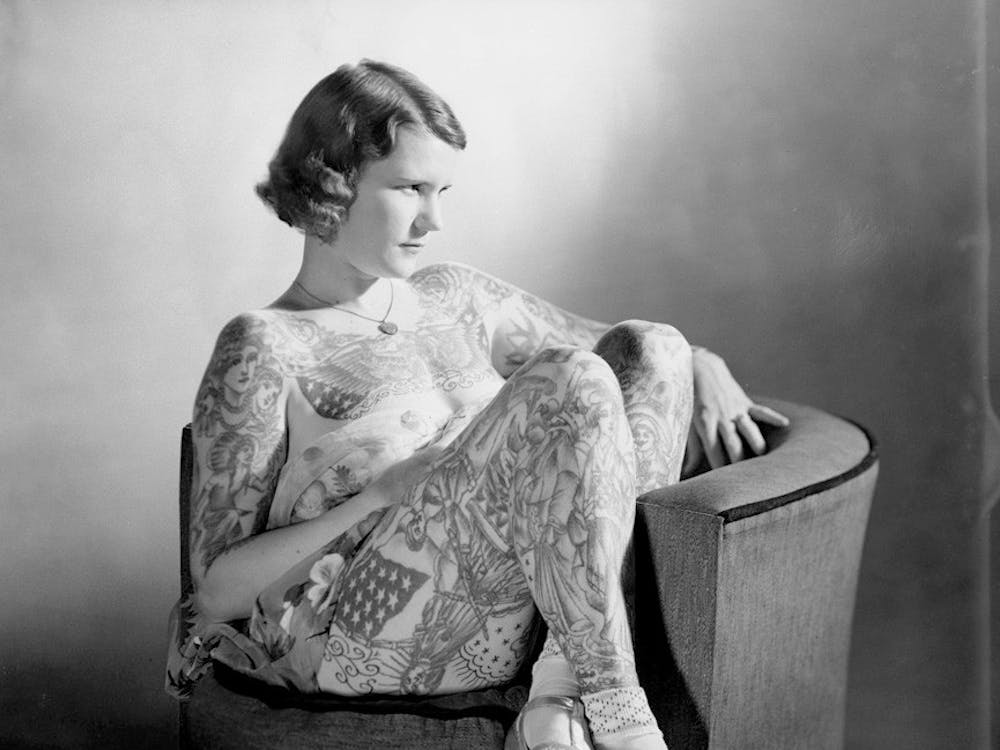Tattoos have undergone a revolution within the past two decades. This form of body modification once associated exclusively with bikers, sailors and criminals is now considered an art form, found on people of diverse backgrounds and professions. According to the 2013 documentary “Tattoo Nation,” one out of every three adults under 40 in the United States now has a tattoo. The history behind tattoos, however, often goes ignored. How long have humans been decorating their skin? Why did negative stigmas develop? C.W. “Chuck” Eldridge answered these questions Nov. 10 during his “Tattoo History 101” presentation at Choice Tattoo in Durham.
Eldridge, a native North Carolinian, started tattooing in California in the 1970s and in 1980 opened the Tattoo Archive in Winston-Salem. He has been featured in publications including Skin & Ink Magazine, Tattoo Master Magazine and Tattoo Artist Magazine as well as the “Tattoo” episode of Netflix’s series “Explained.”
With a thick white mustache, red baseball cap and tattoo sleeves that have remained vibrant since the ‘70s, Eldridge is instantly recognizable as an expert in his craft. Alongside his presentation at Choice Tattoo, the Winston-Salem-based bookstore, BookMistress, sold books, postcards, stickers and vintage business cards related to the tattoo industry. The event itself was free, and donations went to the Freedom German Shepherd Rescue. Embracing the open-minded attitude of the tattoo community, Eldridge brought his own German Shepherd, Murphy, to the shop and invited people in the audience to “yell out questions as they come.”
In his presentation, Eldridge traced the history of tattoo styles, purposes, tools and stigmas from 3300 B.C. to the 21st century. The tattoo expert revealed how the act of puncturing one’s skin with ink has been used for medicinal and social reasons across the globe for centuries.
“There is no culture that didn’t engage in body decoration,” Eldridge explained. “And often this decoration was tattooing.”
The aboriginal people of North America, New Zealand, Japan and West Africa used their bodies as a canvas for centuries before tattoos became taboo in the Western world. Tattoos were frequently used as markers of maturity or loyalty within communities.
By the late 19th century, however, tattoos were deemed indecent in the West. Women such as Irene Woodward and Betty Broadbent were put on display in circuses and sideshows as “The Tattooed Lady,” where the curious could admire the scandalous art covering their bodies. Although several people made careers out of being a tattooed attraction, they still had to hide their bodies to be accepted in everyday society.
“I think religion, primarily Christianity, is a big reason why tattoos have been looked down upon,” Eldridge said. “The Bible says not to mark your skin, and people interpreted that as a rule against tattoos. But as religion changed — as people began to pick and choose what parts of the Bible were literal — the culture changed too.”
Throughout the 20th century, tattoo culture flourished; Eldridge displayed a series of photos of bold back pieces and sleeves that emerged in the decades following WWII. One particular piece on San Francisco-based Dean Dennis from 1976 reveals the prominence of patriotism in American tattoos. By using tattoos as a symbol of dedication to one’s country, artists and clients were able to alleviate stigmas surrounding the art style.
“In the tattoo world, everything goes in a cycle,” Eldridge said. “There were artists that quit tattooing because it was ‘the devil’s work,’ but after the younger generation started getting tattooed, [artists] started tattooing again. What goes around comes around.”
Most tattoos of the time followed what is now known as “American traditional” style: bold lines, primary color palettes, large, curvy fonts and images combining anything from swords and roses to pistols and pin-up girls. When asked about the popularization of new styles such as neo-traditional, linework and watercolor, Eldridge responded with optimism about the expansion of tattooing and acceptance of it as a true art.
“Traditional tattoos are like oldies radio stations — they’ll always be around,” Eldridge expressed. “Good artists are versatile, and sticking with one style gets boring for the artist anyway. I’m happy to see the growth of new styles — it’s the evolution of an art form.”
Eldridge concluded his presentation with appreciation for American tattoo artist Ed Hardy’s style and ability to bring tattoo designs to the fashion industry.
“Back in the day, only sailors, prisoners and loose women had tattoos,” Eldridge explained. “But since the 2000s, tattooing has reinvented itself; now there are magazines and TV shows dedicated to the art. There’s been much more visibility that I believe will only continue. For better or for worse.”
Get The Chronicle straight to your inbox
Sign up for our weekly newsletter. Cancel at any time.

